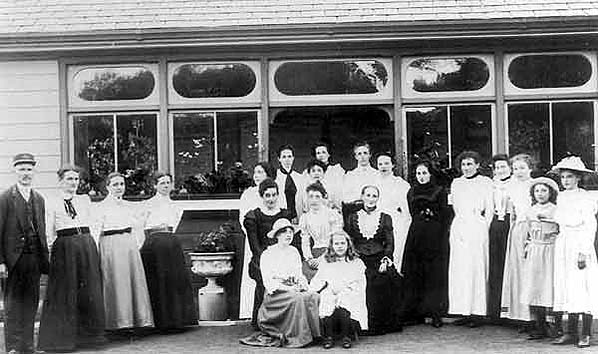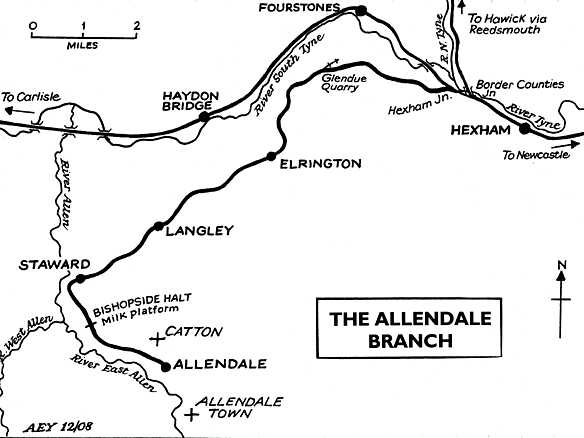Notes: This two-platform station served a small community, Langley Castle, and a lead smelter that was reached by a siding about 600yd to the northeast. The station house beside the up platform presents a brick gable-end to the platform, and has a rather ungainly, rendered pent-roofed addition extending to three storeys where the ground falls away from the platforms. Passenger facilities were provided on the up (northern) platform in a wooden shed with a pitched roof, central sliding door, and flanking windows. The down (southern) platform handled goods and parcels. Livestock was handled in the small goods yard which had a 3 ton crane.
After serving for many years as a post office, the former passenger shed has a new use. Together with the platforms and trackbed, it was delightfully transformed by the the then owner, Jane Torday her aim was ‘to preserve the sense of a secret garden hidden in the woods’. The station is under new ownership Langley Tracks which opened in 2025. They have a suana available, pottery sessions on a wheel and live music in the evening. (From 29.7.1936 the station was renamed Langley-on-Tyne although by this date it was only open for goods traffic.)
BRIEF HISTORY OF THE ALLENDALE BRANCH
From Hexham (Border Counties Junction) this 12¼ mile branch climbed from the Tyne valley through sparsely populated uplands, to Catton in the East Allen Valley. The railway was built as an outlet for the lead smelters that thrived in the mid-19th Century. From 1835, Haydon Bridge station on the Newcastle-Carlisle railway was the link to the outside world. Lead, mined in the local hills and smelted at Allenheads, Langley, or near Allendale Town, was conveyed along cart tracks to the station. However, as foreign competition grew, a cheaper means of transporting the metal was sought. The first attempt to provide rail access failed; in 1846 Parliament rejected the Wear Valley Extension Railway’s proposal to link Frosterley (Weardale) and Alston, with a branch to Allenheads.
In the 1850s major local lead producers and landowners campaigned for rail access, to enable metal to be exported efficiently, and good quality coal to be brought to the smelters from Tyneside. The Hexham and Allendale Railway route was surveyed in 1864. It received Royal Assent on 19 June 1865. The enabling Act permitted the section from Allendale Town to Allenheads to be omitted if financial or other problems were encountered. The North Eastern Railway was enthusiastic, subscribing £10,000 to the initial cost.
The Engineer, Thomas J. Bewick, faced the task of taking the railway from approximately 150ft to almost 800ft across hilly terrain. Much of the single-track route required cuttings or embankments, and curves as tight as 15ch radius. Trains would face a punishing gradient of up to 1 in 50 for the 7 ¾ miles from Border Counties Junction to Langley. A similar climb confronted trains from the southern terminus to Staward. The route was chosen to serve the smelter at Langley, and the terminus was close to another smelt mill at Catton. The Allenheads extension would include steep gradients, again up to 1 in 50, curves of 10 to 12½ chains radius, and substantial earthworks.
On 19 August 1867 the line opened to goods, minerals and livestock from Hexham to Langley, and to Catton Road - almost a mile short of Allendale Town - on 13 January 1868. Passenger services, provided by the NER, commenced on 1 March 1869 serving intermediate stations at Elrington, Langley, and Staward.
| Hopes for lucrative mineral traffic quickly faded. By 1870 the lead industry was declining. Jobs in mines and smelters were lost, and the population drifted away. The smelters at Langley and Allendale had closed by the mid-1880s, and only one important lead mine (near Allenheads) survived until World War I. The population of Allendale parish fell from 6,401 in |
 |
1861 to approximately 2,000 in 1911. In this harsh economic climate, the Allendale Town extension (and the further 7 miles to Allenheads) was not attempted. The struggling Hexham & Allendale was bought out by the NER on 13 July 1876. Although the NER surveyed an extension into Allendale Town in 1898 – the intended terminus if the Allenheads section was abandoned - the railway progressed no further than Catton Road, and that year the terminus was renamed Allendale.
Signalling on the branch was unsophisticated. In the absence of signal boxes, ground frames, operated by the guard or porter, controlled passing loops at each station and permitted access to sidings.
For a little over 60 years a modest service of passenger trains operated. In 1920 there were three workings in each direction on weekdays, with an extra afternoon train on Tuesday (Hexham market day) from Hexham to Allendale and back: the service had changed little since the branch was opened. Thirty-three minutes were allowed for the Hexham to Allendale journey, and three minutes less for the return. Hexham-based 0-4-4 or 2-4-2 locomotives normally worked the trains. In 1910, a visitor was impressed by the quality of stock operating on the branch, consisting of elliptical-roofed two-bogie carriages, lit by electricity rather than gas.
 |
Goods traffic included milk from a creamery near the terminus and from Bishopside Halt (between Staward and Allendale), lead products, livestock, fodder, timber, coal, and general merchandise. Stone was collected at a siding serving Glendue Quarry, northeast of Elrington. The lonely countryside offered little passenger business, and ticket sales were meagre: Elrington issued only 927 and Langley 2,976 in 1911. Staward’s total of 4,547 and Allendale Town’s of 10,691 did not approach half the issues at nearby Fourstones and Haydon Bridge. Ticket sales changed little by 1923, but by 1929 they declined by over 70%; branch station receipts fell by over 80%. In 1926 the economy was made of closing Elrington’s booking office. In June 1930 the LNER reviewed the finances of the branch and a memorandum to the Traffic, Works, and Locomotive Committees contained the following statistics.
Passengers Booked |
Receipts £ |
| STATION |
1923 |
1929 |
1923 |
1929 |
| Allendale |
11,712 |
3,493 |
2,092 |
358 |
| Staward |
3,339 |
1.173 |
401 |
80 |
| Langley |
2,860 |
655 |
234 |
51 |
| Elrington |
1,155 |
(Halt) |
87 |
- |
The branch’s plight was emphasised by comparing receipts of the first quarters of 1929 and 1930: Allendale’s fell from £156 to £91; Staward’s from £38 to £21; and Langley’s from £13 to £9. The losses were unsustainable. Closure would result in an estimated loss of £1,685 revenue (including bookings to the line from Hexham and beyond) but savings in expenditure of £4,687. The breakdown of expenditure was:
| Locomotive power |
£2,317 |
| Guard |
£185 |
| Carriages |
£542 |
| Cleaning, lighting, heating, oiling |
£184 |
| Station staff |
£792 |
| Engineer: permanent way maintenance |
£667 |
One G.5 tank locomotive and 106 coach seats would be released.
After passenger closure it was expected that parcels and ‘miscellaneous passenger train traffic’ would not suffer appreciable loss of receipts, and that a parcels train would be introduced.
The review recognised that buses had caused the branch’s financial problems. Robert Emmerson ran buses at two-hourly intervals between Newcastle, Hexham and Allendale Town, via Haydon Bridge. Wharton’s buses plied at 75-minute intervals between Hexham, Haydon Bridge, Langley, Catton, and Allendale Town. The fastest buses equalled the train journey time, but linked the centres of Hexham and Allendale, rather than their inconveniently sited stations. Emmerson’s was a subsidiary of United, an Associated Company of the LNER, and the review assumed that a considerable proportion of the rail loss would accrue to that company. Herein lies a reminder that railway companies sometimes had a financial interest in what appeared to be their competitors. The review acknowledged hardship that closure would bring to Elrington ‘where the sparse population will have a little longer walk to the bus than they have at present to join the trains’.
In December 1929, having heard rumours of the closure of their branch, a deputation from Allendale approached the LNER General Manager to demand the retention of the service. It was pointed out to them that trains were poorly patronised and that, unless traffic increased, no assurance could be given that the service would continue. The review concluded that because of the marked decline in traffic ‘it seems clear that any complaints from the public regarding the withdrawal of the passenger train service can be readily dealt with’.
On 22 September 1930 passenger services ended, but goods traffic continued until 20 November 1950. The rails were lifted, and the Ordnance Survey One-inch map published 1956 showed a line remaining only from Elrington to Border Counties Junction. Much of the branch can be traced today. From Glendue Siding to Langley the trackbed is a footpath.
Tickets from Michael Stewart
Sources:
To see other stations on the Allendale branch click on the station name: Hexham, Elrington, Staward, Bishopside Halt & Allendale |

old1.jpg)


1.jpg)
2.jpg)
12.jpg)



old_thumb2.jpg)
thumb13.jpg)
thumb14.jpg)
thumb15.jpg)
thumb3.jpg)
thumb7.jpg)
thumb8.jpg)
thumb10.jpg)
thumb9.jpg)
thumb13.jpg)

 Home Page
Home Page